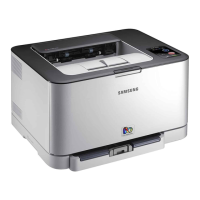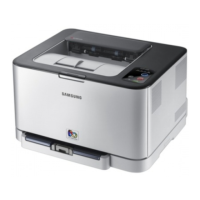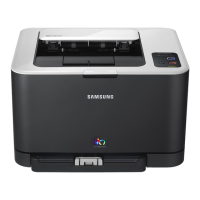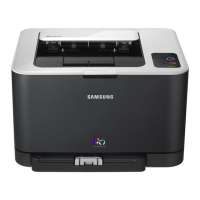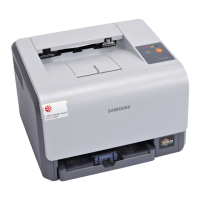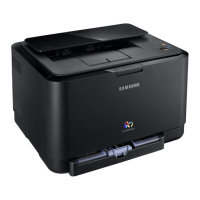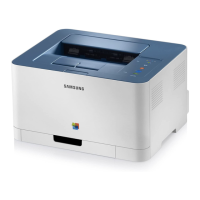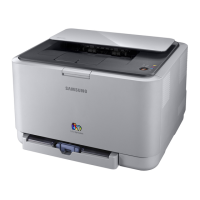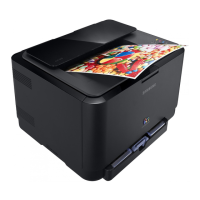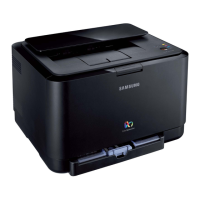Do you have a question about the Samsung CLP-320N and is the answer not in the manual?
Provides an overview of the printer's physical components, including front and rear views.
Explains the buttons and LEDs on the printer's control panel for different models.
Details the meaning of status, toner, and wireless LEDs and their operational indications.
Guides through the physical setup of the printer, including location and unpacking.
Instructions for installing the printer software from the CD or Samsung website.
Lists the minimum hardware and software requirements for Windows, Macintosh, and Linux.
Step-by-step guide for installing the printer driver via a USB connection.
Instructions on how to share the printer with other computers on a local network.
Overview of supported network interfaces, operating systems, and protocols for network setup.
Description of software utilities like SyncThru™ Web Service for network management.
Steps for connecting and configuring the printer using a wired network cable.
Guide for installing the printer driver for network-connected machines.
Introduction to wireless setup, covering connection types like Infrastructure and Ad-Hoc.
Information on setting up the SSID and network key for secure wireless connections.
Explains different methods for wireless setup, including control panel and computer.
Step-by-step instructions for configuring wireless settings using the WPS button.
Guide to setting up wireless connections using a USB cable or network cable via computer.
Instructions on how to enable or disable the Wi-Fi network using SyncThru™ Web Service.
Solutions for common problems encountered during wireless setup and driver installation.
Explains how atmospheric pressure affects print quality and how to adjust settings.
Guide on selecting default paper trays and types for printing jobs.
How to conserve power by using the machine's power saving settings.
Instructions for changing default fonts for specific regions or special conditions.
Guidance on adjusting settings for humid environments to maintain print quality.
Guidelines for choosing appropriate paper, envelopes, and labels for printing.
Instructions on how to adjust paper guides in the tray for different paper sizes.
Step-by-step guide on how to load paper correctly into the paper tray.
Information on printing with various special media types like envelopes, labels, and photos.
How to configure paper size and type settings in the printer driver for accurate printing.
Information about the output tray and its support for aligning printed pages.
Overview of included software like Samsung AnyWeb Print and Easy Color Manager.
Details on standard and special printing features supported by the printer driver.
General steps for printing documents from various applications and operating systems.
How to access and modify print settings through the Printing Preferences window.
Explains advanced features like printing multiple pages per sheet and posters.
Overview of tools for managing and monitoring the printer's status and settings.
Detailed guide on using the embedded web server for printer configuration and monitoring.
How to use the Smart Panel application for monitoring status and managing settings.
Guide for configuring printer settings specifically for Linux operating systems.
Instructions on printing a configuration page for troubleshooting or checking settings.
Procedures for cleaning the printer's exterior and interior to maintain print quality.
Guidelines for proper storage of toner cartridges to maintain their condition.
Advice on safely moving and storing the printer to prevent damage.
Steps to improve print quality when toner colors are unevenly mixed.
Recommendations on media selection and handling to prevent paper jams.
Detailed instructions for removing jammed paper from various locations in the printer.
Solutions for system, power, paper feeding, printing, and quality issues.
Information on where and how to order genuine Samsung supplies and parts.
List of consumables like toner cartridges, imaging units, and waste toner containers.
Information on parts that require replacement at specific intervals for optimal performance.
Step-by-step guide for replacing the toner cartridge when it is depleted.
Instructions for replacing the imaging unit when it reaches the end of its lifespan.
Procedure for replacing the waste toner container when it is full.
Technical details about the printer's physical dimensions, weight, and components.
Information on operating temperature, humidity, and noise levels.
Details regarding power requirements, consumption, and voltage.
Comprehensive list of supported paper types, sizes, weights, and their properties.
Explains the meaning of safety symbols and icons used in the user's guide.
Provides detailed explanations for all icons and signs found throughout the user's guide.
Details precautions and warnings related to the printer's operating environment.
Information regarding the printer's compliance with laser safety standards.
Notes on ozone production during operation and recommendations for ventilation.
Details on the printer's energy conservation technology and ENERGY STAR compliance.
Information on environmentally responsible disposal of product packaging.
Guidelines for the proper disposal of the product and its electronic accessories in the EU.
FCC and Canadian regulations regarding radio frequency emissions from the device.
Information on compliance with Canadian standards for digital apparatus noise emissions.
FCC compliance information, including intentional emitters and FCC statements.
Specific information for Germany, including plug replacement for UK.
Instructions for safely replacing the mains plug and fuse for UK users.
Details on CE marking and compliance with EU directives for the printer.
Information for products fitted with EU-approved radio devices and country qualifications.
General guidance and country-specific considerations for operating wireless devices.
The license agreement for the OpenSSL cryptographic software used in the product.
The license agreement for the SSLeay SSL implementation software.
Explains formatting conventions and terms used throughout the user's guide.
Lists resources for additional setup and usage information, including guides and websites.
Highlights key features like print quality, speed, media handling, and professional document creation.
Compares features included across different printer models.
